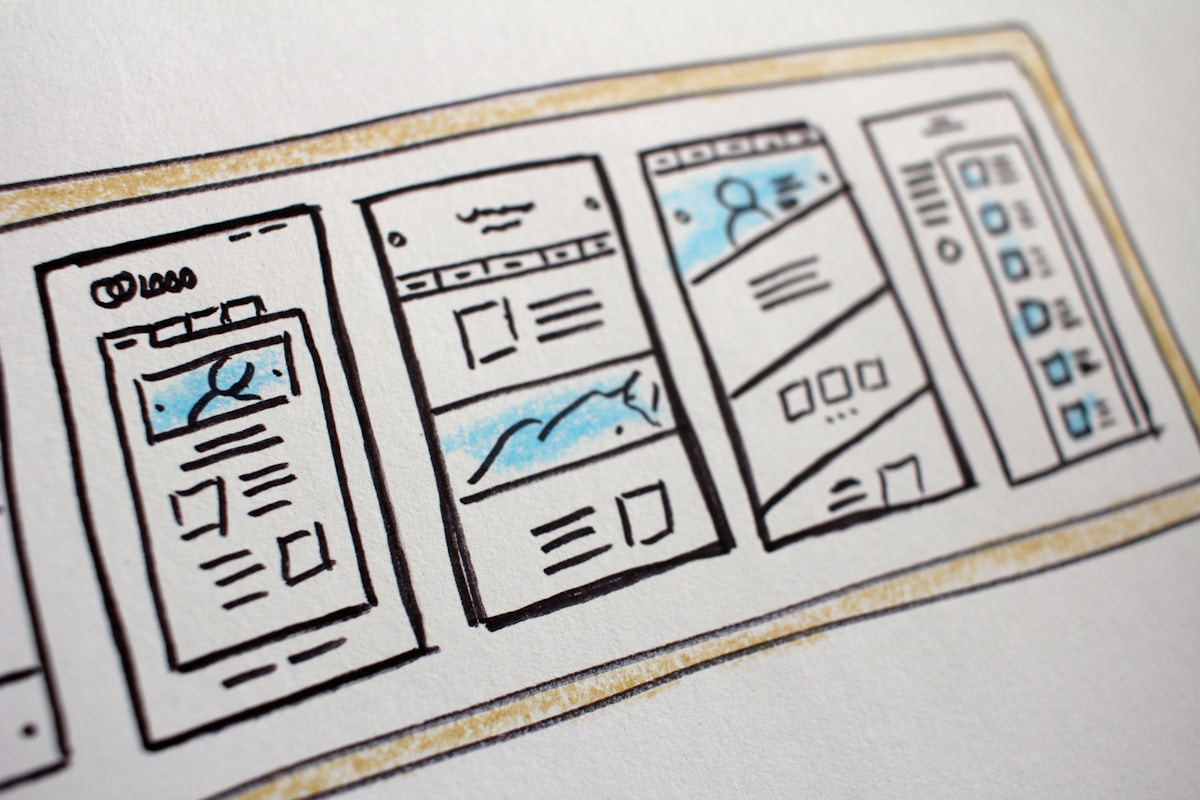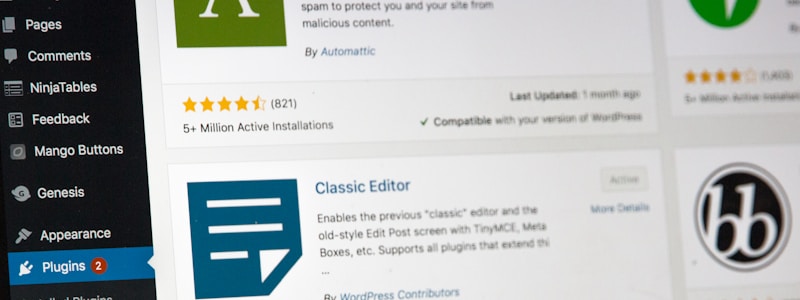How to build a website that works for real people.
December 1, 2023
Welcome to my brand new website building guide and updated AI-assisted user-focused website builder platform!
For decades I've offered cutting-edge website creation tools + web hosting services through many brands (including on this website) and I'm excited to be renewing that mission with vigor as we turn the page into 2024.
This new tutorial and website creation and planning framework is a work-in-progress that I'm going to release early (before it's even complete) and refine over time. The unique thing I'm hoping to do is integrate a basic website creation and planning process into the guide, providing a useful no-strings attached take-away document that you can use to help plan your own website build, or give to a professional to get them started.
Thanks so much for taking an early look, and I'd love to hear any feedback you have!



Before we dig in, here's the punchline 🤭
Over the years, as time and website tech have marched on, one concept has begun to really stand out to me, as it's been reinforced again and again over the years:
What works best in the long run to build an effective small business website is staying focused on the needs of real people – your ideal customers.
So that's the core of this updated guide – how to build a serious small business website from scratch that works in today's world, for today's real people – from someone who's been there and done it hundreds of times.
What works best in the long run to build an effective website is staying laser-focused on the needs of real people – your customers

Step 1 - Know your "who" and "why"
In the early stages of a new website build, it's easy to skip right ahead to the latest visual trends or technical approaches – and those are important when the time is right (we'll cover them in this guide too) – but too often, these areas become a distraction* from what's really critical as the baseline to move forward successfully.
* As a side note, this word dis-traction really struck me as I wrote it here. I've never noticed before how clearly it speaks to 'getting off track' or 'losing traction' – sitting in a car, unable to gain momentum, wheels spinning, stuck in mud or snow, getting nowhere but expending frantic energy... I suppose that this quick side-note is a "distraction" in itself – but perhaps useful in the big picture!
So, as our first step... let's build real traction with a user-centric foundation!
Identify Your Website's Purpose
Starting with an objective also helps you to choose a best web development tool. Generally speaking, when you are selling products, choosing an e-commerce platform is the best, or conversely if you're creating a personal blog, using a blogging-focused platform makes the most sense.
Using the input boxes below, do your best to work through the following:
- Identify your target audience in terms that are relatable.
- Clarify their needs by describing their goals and pain-points, why do they care about your website?
- Explain your site's value in one brief, engaging, and understandable title (headline) and subtitle.
As you work through the exercises, your answers will be saved securely (in your web browser only)
Then, toward the end of the guide, you can (optionally) submit these answers to generate a free website from scratch using our AI tools.
You'll also have the option to email yourself a PDF brief to pass along to your team or service provider to move your project forward.
As we've already been highlighting at length, knowing your users and their "why" is critical to success.
There are also more involved and advanced ways to do this, and of all the "side quests" that I suggest in this guide, this next one is perhaps the most valuable:
A great way to dig deeper in understanding your customers and stakeholders is through a concept called "user personas" and it's a very effective way to get under the surface and paint a comprehensive, relatable picture your user groups, which can inform and drive decisions for all aspects of your website and marketing.

Summing it up before we move forward with other guide topics:
- Devoting some time up front to dig underneath the surface of the shiny technology and pretty designs to the "who" and "why" of your project will bear good fruit in the long run.
- Whether you build your own site with our tools, hire us to help, or use other online tools or service providers, I hope you'll focus on building for real people and adding genuine value to their lives.
Step 2 - Plan your content strategy
Notice we're still not jumping into the visual or technical stuff? That's because to really get a professional website, we need to work like pro's - which is to say with intention and clear direction - and that shapes up best when our content plan is strategic and effectively aligns with the needs and intentions of our end-users.
Content is the core "what" of your website - and it should arise cohesively and organically out of the "who" and "why" we already covered above.

Content strategy is an entire discipline unto itself, but as with the other areas we're covering, it works well to start pragmatically and build deeper later.
I believe that there's immense benefit to be gained from spending even a short amount of time working through a content strategy before jumping into design and tech considerations.
Below is an inventory I've designed help you walk through the steps of a very high-level content definition process, helping you establish the library of content types that your various website pages can display to meet the goals and challenges your end-users where they're at.
Step 3 - Establish your design path
Finally, the pretty stuff - but where do we even start on this? And, given that there's a nearly infinite number of ways to arrange the pixels on a screen, why do websites tend to look so similar these days?



As we dive into the topic of design, I hope it's okay to tell another personal story
In 1995 (while still in high school) I landed my first paying job as a web designer and web development intern when the director of a local brand and marketing agency noticed my use of HTML tables to create a print-like layout (at that time, many websites were still plain text with just a few images).

This technique quickly became mainstream, but it was eventually entirely replaced with newer ways of designing sites so they'd work well on both mobile devices and computers.
Today we don't use HTML tables for web page layout because there are better ways to achieve the same result. But now, as it was then, good design remains as critical to success.
Technical evolution aside though, why have the differences between websites become so much more subtle over the past 10 or so years?
The biggest reason (and this is mostly good) is that modern websites tend follow common, proven, expected design patterns and flows, making it easy to systematize a professional-looking web presence.
But the flip-side of that coin is, it can be more challenging to convey a vivid or unique brand story through your website without introducing usability problems, as visual and functional innovation must be done carefully to remain aligned with well-defined user expectations.
That said, there are still effective ways to differentiate your designs, through systematic use of imagery, typography and subtle design elements.
Some designers don't like the uniformity of the modern web - it can limit or constrain creative expression - but at the same time, in many ways end-users benefit from these common "best practice" design patterns and predictable user experiences.
The good thing about this catch-22 is that it makes creating unique-looking designs that still function well for end-users an engaging challenge for motivated web design professionals.
Many organizations have established design and brand guidelines covering areas like typography, brand colors, logos and placement, and other design elements such as spacing, line-work, etc. If your organization already has a design or style guide, this can be a very helpful way to reduce the complexity of designing your new website.
Our current in-house website builder platform goes with the grain of this trend by facilitating a content-first approach (by contrast, many legacy website builders still approach onboarding with a design template or "theme" choice as primary).
Under the hood, every design element is fully customizable, but we're proud of how quickly we can help you launch a clean, industry-standard, mobile-and-desktop friendly design, with your core brand elements such as typography, logos, and colors applied.
Step 4 - Choose your tech platform
Today there are many website builders and thousands of technical platforms available to build websites, and new options are still being launched every week!

As someone who's been designing and coding site builder platforms from scratch every few years, I can confidently say there isn't one size that fits every need.
There are a few very well-known platforms, like Wordpress, which nearly everyone's heard of (has its strengths and weaknesses), an ever-growing number of well-known hosted platforms, like Wix, SquareSpace or Shopify... all of these can be great options, in the right scenario.
Then there are the thousands of vendors (including yours truly) who will build you a completely custom site, which can also work very well (especially with the right partner)
Our guiding principle, learned over hundreds of projects built on many different platforms, is that the more specific, niche and intricate your needs are, the better results you'll get with a custom build, or an advanced website platform.
Wordpress is a common example of a platform that's often pushed beyond its sweet spot.
Although it started as a simple blogging tool (and still works fine for many more traditional article publishing workflows), Wordpress has become far more capable than that now, and can be extended a great deal further with a huge marketplace of available plug-in's.

But this critical mass comes with a downside - too often I've seen the promise of "we'll just enable this Wordpress plugin" devolve into vast amounts of human effort required to set up and maintain the platform (for advanced configuration) which far exceeds the time and budget needed for the same results using a platform more suited to advanced configuration (or even a custom build).
Don't get me wrong, I've seen (and helped out on) some impressive, highly customized websites built entirely on Wordpress, but I've also been brought in as a coding expert to work on some of them, and while I'm impressed by what can be done, I can also attest that current technology is 99% of what's often still done using legacy tools.
In many ways, as in other areas of life, the best website builder platform for you is the one that's readily available while also aligning with your user + feature goals, content strategy, budget, and team resources.
I'd be grateful if you'd consider our services for your website needs. Obviously we're experts in our own software, but we're well-equipped and experienced with deploying other platforms too (even Wordpress!)
If you want to explore working with us, you can get started for free from the AI-assisted self-builder dashboard, and proceed to partner up with us right from the dashboard.
Step 5 - Produce compelling content
You've already made your content plan, and with the right tech platform you have somewhere to put your content. Great content is engaging, involving mix of text, photos, illustrations, videos, intake forms, and even custom functional pieces like games or custom interactive elements (like the brief creator integrated into this tutorial)

Job one in this step is to identify the key topics and themes that will resonate with your target audience from Step 1. To do this, create an inventory of possibilities, then refine them.
As you write, be sure to establish and follow a consistent tone and voice with your content, following any brand guidelines that are established by your organization.
Once you've begun producing content (with end-user relevance as your starting point) it's also a good idea to research SEO keywords. This can be tricky area - many years ago, search engines responded positively to "keyword stuffing" but these days that technique is far more likely to do harm than good to your cause.
Today, most search engine optimization guidelines are clear on this point: by following the north star of this guide and focusing on user value you'll stand the best chance of creating content that (eventually) ranks on search engines like Google, DuckDuckGo, and Bing.
It's important to write engaging, original content - both in terms of unique text and also unique concepts, based on solid research and valid personal expertise.
While it might be tempting to use AI-based tools as a short-cut to producing the bulk of your content, I believe we can be pretty confident that Google and other search engines will continue to find new ways to discover and elevate unique and valuable content that's been carefully written by real humans, while de-prioritizing the outputs of systematic and automated processes, as they have been doing for years already.

Since today's AI writing tools, by definition, use internal averages and prediction that duplicating past concepts on a vast scale, they're best used sparingly in your final content production workflow, even though they can be excellent to help build momentum, check your work, and brainstorm options.
As you begin to create, build a website, and publish content using your platform of choice, it's also important to remember that scheduled updates (factual correctness, completeness) will help your site remain relevant to end-users (and search engines will appreciate these updates as well)
Step 6 - Find the right domain name
As a bit of a preface, I want to acknowledge that here near the end of 2023, most organizations already have a domain name.
If that's you, and you're happy to keep that free domain (meaning it won't add any new cost to your website build), please feel free to skip ahead to the end, note down the site address for your domain, and move on.
If you happen to be building a website for an entirely new business, it's possible that you haven't even decided on a name yet.
The positive side of that is leaves you with a LOT more options for domain names, but the tricky side of it is that you also have a lot of other things to consider, which aren't (yet) covered in our guides.
Even if you're just starting out, you probably already understand what a domain name is (contrast that with the earliest versions of guides like this I wrote two decades ago) - but by now, most people understand that the thing that goes in the address bar of a web browser is a domain name, and that those are available for purchase (or more accurately, for lease) on an annual basis.
Domain names are comprised, from right to left of a TLD (Top Level Domain) and a number of sub-domains. There are a vast array of new domain name TLD extensions (nTLD's for short) that have emerged throughout the past decade.
Each of these new extensions has a varying degree of popularity, but many folks still prefer the trusted standards of ".com" for the web pages of typical businesses, and ".org" for non-profit websites.
Also popular for local businesses are country level TLD's like .co.uk (for the United Kingdom) or .ca (for Canada), and so on for other countries.

A third key note in the area of TLD extension choice are a few standout TLD extensions that are actually country-codes but which for various historical reasons have become de-facto generic extensions (and in many cases very popular as such).
The most well-known examples of this are the .io and .co extensions (for Indian Ocean Territories, and Columbia [South America], respectively).
For many small businesses however, choosing a .co or a .io domain name when the .com is taken (especially when the .com is not in use and could be acquired later) is an effective way for small businesses to obtain a short, relatable domain name to express their brand online.
Register your domain and choose design and hosting providers
After you've selected the domain you will need it registered at the domain registration service. You can do this via websites ranging from domain.com to Network Solutions. These providers can simply register the domain for you and the cost of this is typically around $10-25 a year depending upon your TLD.
For ease of registration and launch you may wish to use an internet hosting service provider with registration and web hosting services that are pre-integrated, saving you the trouble of connecting your new domain name to your web hosting provider. Some design and web development professionals also have preferred domain registration and web hosting providers, in which case it's best to let them work within their preferences for best efficiency!
Step 7 - Build and launch your new website!
At last, having worked through a robust, user and content-driven website building process, you're ready to launch your professional website on the platform of your choice.
Test and launch your new site
You've worked hard to create a great site, but don't hit "publish" just yet! First, conduct a thorough review of all the content before hitting the big "launch" button.
Follow this checklist to ensure everything is correct and looks good, then click "publish". After creating the site, consider promoting it on platforms like Facebook or Instagram, and update all of your online profiles with the new URL.
Launch tips:
- Don't worry about missing a few errors – you can always edit your site any time!
- Never let your fears about it not being "ready yet" prevent your website from being found online.
- Launching your site is more satisfying than waiting for perfection.
More details will follow here soon, thanks for your patience as I get this fun new resource off the ground!
Step 8 - Go beyond the basics
Building a compelling website is more than just throwing together pages and content. It's about creating a digital environment that's not only informative but interactive and engaging. Here, we delve into how to add life to your website with features that resonate with your audience.
Note that similar to what I shared at the beginning of this article, the elements below are really just an outline that I hope to flesh out more over time.
Accessibility - access for all
Incorporate design elements that make your site accessible to all, including those with disabilities. Many would argue that this isn't an optional "extra" – and they would be right, however it's typically not covered in basic tutorials which is why we're covering it here.
- Screen Reader Friendly: Make your site navigable with screen readers.
- Keyboard Navigation: Ensure all elements are accessible via keyboard.
- Adjustable Display Options: Offer text size and contrast adjustments for better readability.

Advanced contact pages
Your contact page is essentially your digital handshake – it's where connections are made. It's vital in establishing a rapport with potential clients, curious visitors, and potential partners.
- User-Friendly Design: Keep your form simple but complete. Request only necessary information and make it easily findable.
- Diverse Contact Methods: Acknowledge different preferences – some may prefer emails, others phone calls, or even a physical address. Provide these options.
- Maps and Social Links: For physical businesses, maps are a welcoming touch. Linking social media profiles encourages ongoing engagement.

Intake forms for onboarding
Intake forms are the unsung heroes for service-based websites, setting the tone for user interaction and shaping first impressions.
- Effortless User Journey: Design your intake forms for clarity and ease of use. Logical question sequencing and clear language are key.
- Privacy and Trust: In an era where data privacy is crucial, transparent privacy policies and secure forms are non-negotiables for building trust.

Registration and events
The registration process is often the first active engagement a user has with your site. A streamlined, secure, and straightforward registration experience sets a positive tone for their journey on your platform.
- Efficiency is Key: Minimize the steps and required information. Offer a guest option for e-commerce to speed up transactions.
- Social Media Integration: Enable registration via social media accounts to simplify the process.
- Security First: Implement strong security measures like two-factor authentication to protect users and enhance your site’s credibility.

Custom interactions and engagement
Interactive elements like quizzes, polls, and calculators turn passive browsing into active engagement, offering valuable insights into user preferences and behaviors.
- Relevant Interactions: Align these features with your audience’s interests. A financial site might include calculators, while a health site could offer symptom checkers.
- Feedback Opportunities: Use these tools for feedback collection, making users feel valued and providing you with actionable insights.

Online sales and e-commerce
For e-commerce sites, every step from product browsing to checkout should be intuitive and seamless.
- Product Galleries that Speak: Ensure high-quality images, detailed descriptions, and an intuitive layout for a smooth browsing experience.
- Shopping Cart Optimization: The shopping cart should be easily accessible, update in real time, and lead effortlessly to checkout.
- Payment Flexibility: Offer a variety of secure payment methods to cater to different user preferences.

Personalization and customization
Personalization enhances the user experience, fostering loyalty and repeat visits.
- Custom Profiles: Enable users to set preferences for content viewing and notifications.
- Recommendation Engines: Utilize user data to suggest relevant content or products, adding a layer of personal touch.
- Localization: Automatically adjust content based on the user’s location for a more relevant experience.

Analytics and Feedback
Utilize analytics and feedback tools to understand user behavior and continuously refine the user experience.
- Behavior Tracking: Employ analytics to monitor how users interact with your site.
- User Feedback Collection: Regularly gather user insights through surveys or feedback forms.
- Performance Metrics: Keep tabs on website performance metrics like load times to ensure a smooth user experience.
